Android ORM 框架之 greenDAO 使用心得
前言
我相信,在平时的开发过程中,大家一定会或多或少地接触到 SQLite。然而在使用它时,我们往往需要做许多额外的工作,像编写 SQL 语句与解析查询结果等。所以,适用于 Android 的ORM 框架也就孕育而生了,现在市面上主流的框架有 OrmLite、SugarORM、Active Android、Realm 与 GreenDAO。而今天的主角便是 greenDAO,下面,我将详解地介绍如何在 Android Studio 上使用 greenDAO,并结合代码总结一些使用过程中的心得。关于 greenDAO
 简单的讲,greenDAO 是一个将对象映射到 SQLite 数据库中的轻量且快速的 ORM 解决方案。(greenDAO is a light & fast ORM solution that maps objects to SQLite databases.)
而关于 ORM (Object Relation Mapping - 对象关系映射)的概念,可参见 Wikipedia。
简单的讲,greenDAO 是一个将对象映射到 SQLite 数据库中的轻量且快速的 ORM 解决方案。(greenDAO is a light & fast ORM solution that maps objects to SQLite databases.)
而关于 ORM (Object Relation Mapping - 对象关系映射)的概念,可参见 Wikipedia。
GREENDAO 设计的主要目标
- 一个精简的库
- 性能最大化
- 内存开销最小化
- 易于使用的 APIs
- 对 Android 进行高度优化
GREENDAO 设计的主要特点
- greenDAO 性能远远高于同类的 ORMLite,具体测试结果可见官网
- greenDAO 支持 protocol buffer(protobuf) 协议数据的直接存储,如果你通过 protobuf 协议与服务器交互,将不需要任何的映射。
- 与 ORMLite 等使用注解方式的 ORM 框架不同,greenDAO 使用「Code generation」的方式,这也是其性能能大幅提升的原因。
DAO CODE GENERATION PROJECT
 这是其核心概念:为了在我们的 Android 工程中使用 greenDAO ,我们需要另建一个纯 Java Project,用于自动生成后继 Android 工程中需要使用到的 Bean、DAO、DaoMaster、DaoSession 等类。
这是其核心概念:为了在我们的 Android 工程中使用 greenDAO ,我们需要另建一个纯 Java Project,用于自动生成后继 Android 工程中需要使用到的 Bean、DAO、DaoMaster、DaoSession 等类。
CORE CLASSES & MODELLING ENTITIES
关于以上几个类的相关概念与作用,我将在下面的代码(注释)中详细讲解。 当然,你也可以在 官网 中找到相关介绍。让我们开始吧
一. 在 ANDROID 工程中配置「GREENDAO GENERATOR」模块
- 在 .src/main 目录下新建一个与 java 同层级的「java-gen」目录,用于存放由 greenDAO 生成的 Bean、DAO、DaoMaster、DaoSession 等类。
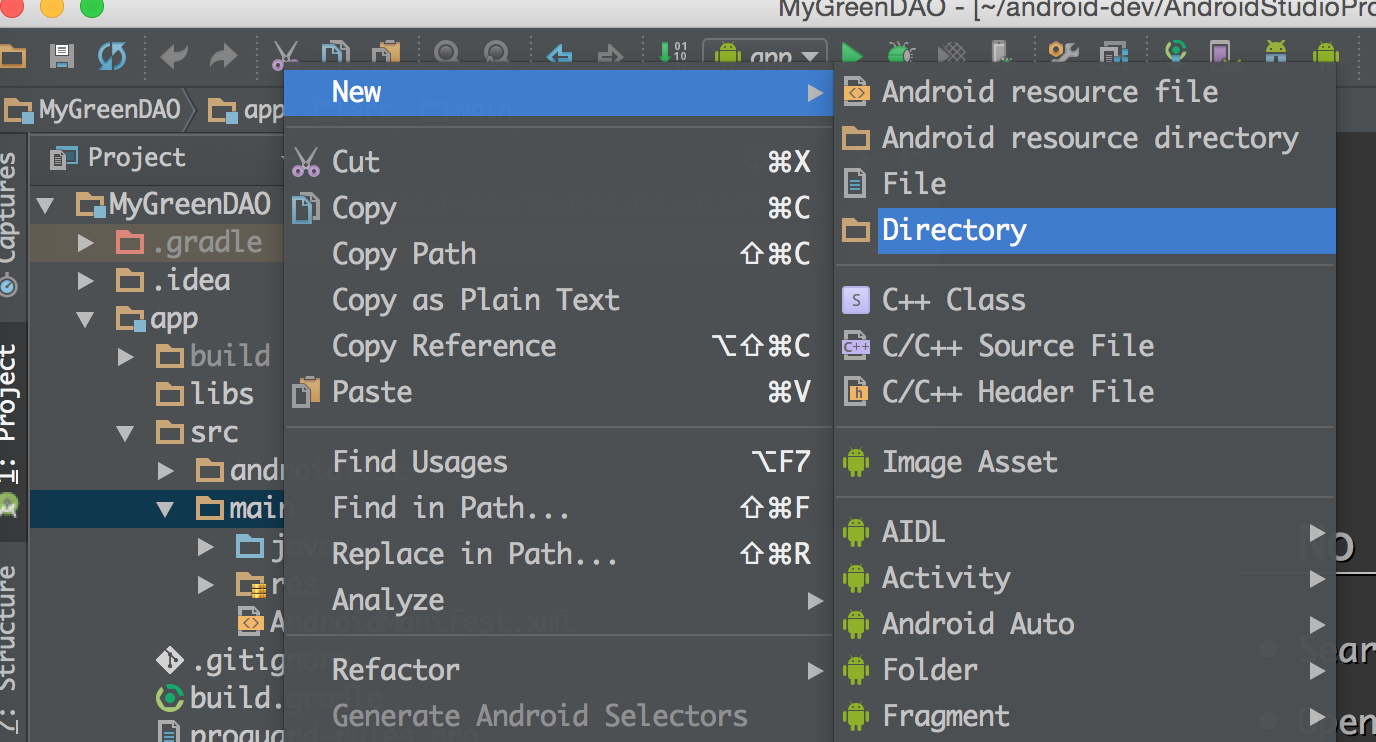

- 配置 Android 工程(app)的 build.gradle,如图分别添加 sourceSets 与dependencies。

|
1
2
3
4
5 |
sourceSets { main { java.srcDirs = ['src/main/java', 'src/main/java-gen'] } } |
|
1 |
compile 'de.greenrobot:greendao:1.3.7' |
二. 新建「GREENDAO GENERATOR」模块 (纯 JAVA 工程)
- 通过 File -> New -> New Module -> Java Library -> 填写相应的包名与类名 -> Finish.
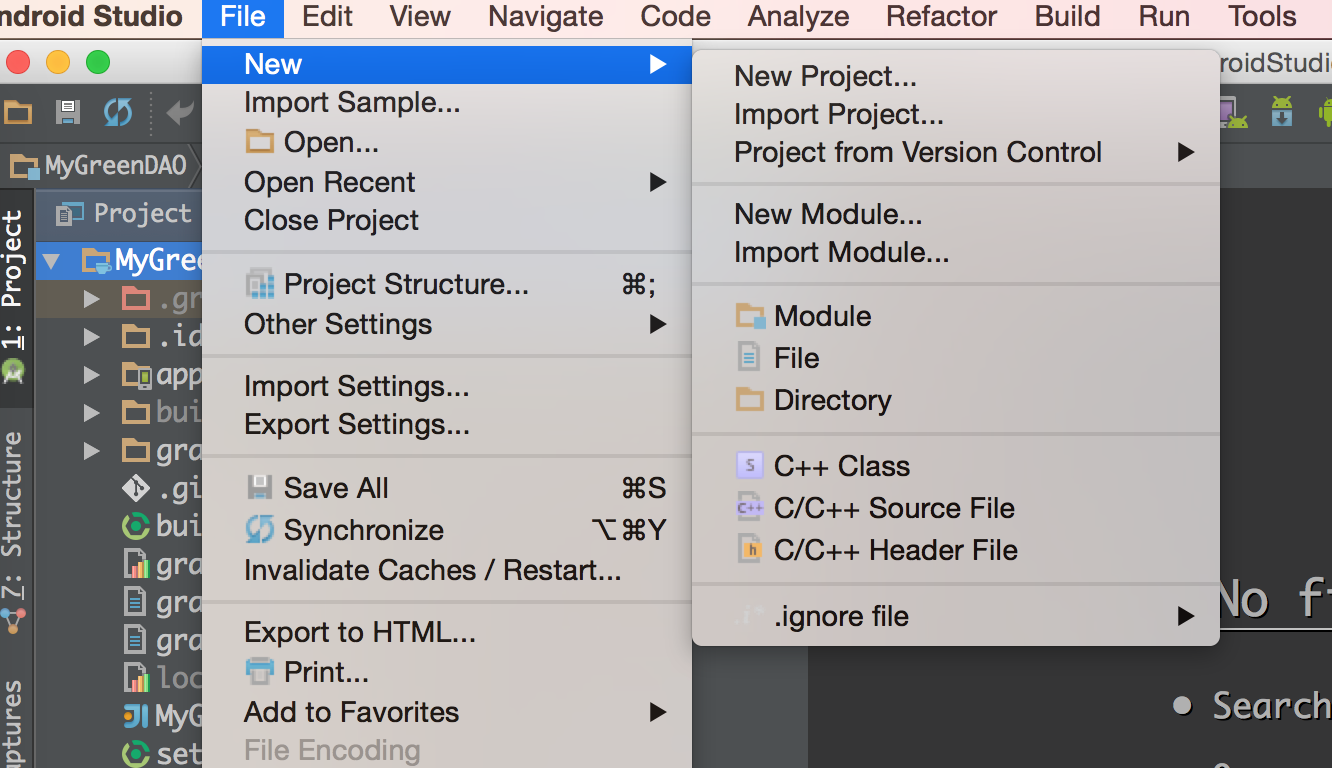

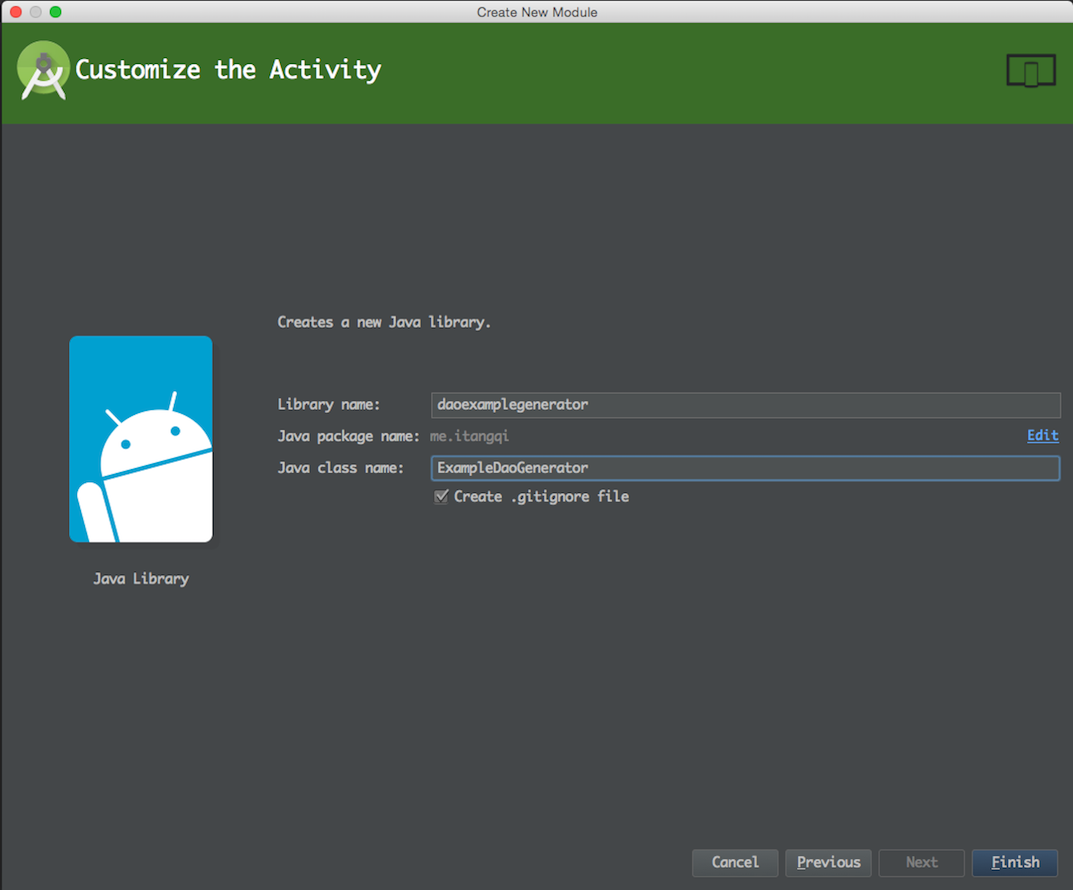
- 配置 daoexamplegenerator 工程的 build.gradle,添加 dependencies.
-

|
1 |
compile 'de.greenrobot:greendao-generator:1.3.1' |
- 编写 ExampleDaoGenerator 类,注意: 我们的 Java 工程只有一个类,它的内容决定了「GreenDao Generator」的输出,你可以在这个类中通过对象、关系等创建数据库结构,下面我将以注释的形式详细讲解代码内容。
|
1
2
3
4
5
6
7
8
9
10
11
12
13
14
15
16
17
18
19
20
21
22
23
24
25
26
27
28
29
30
31
32
33
34
35
36
37
38
39
40 |
public class ExampleDaoGenerator { public static void main(String[] args) throws Exception { // 正如你所见的,你创建了一个用于添加实体(Entity)的模式(Schema)对象。 // 两个参数分别代表:数据库版本号与自动生成代码的包路径。 Schema schema = new Schema(1, "me.itangqi.greendao");// 当然,如果你愿意,你也可以分别指定生成的 Bean 与 DAO 类所在的目录,只要如下所示:// Schema schema = new Schema(1, "me.itangqi.bean");// schema.setDefaultJavaPackageDao("me.itangqi.dao"); // 模式(Schema)同时也拥有两个默认的 flags,分别用来标示 entity 是否是 activie 以及是否使用 keep sections。 // schema2.enableActiveEntitiesByDefault(); // schema2.enableKeepSectionsByDefault(); // 一旦你拥有了一个 Schema 对象后,你便可以使用它添加实体(Entities)了。 addNote(schema); // 最后我们将使用 DAOGenerator 类的 generateAll() 方法自动生成代码,此处你需要根据自己的情况更改输出目录(既之前创建的 java-gen)。 // 其实,输出目录的路径可以在 build.gradle 中设置,有兴趣的朋友可以自行搜索,这里就不再详解。 new DaoGenerator().generateAll(schema, "/Users/tangqi/android-dev/AndroidStudioProjects/MyGreenDAO/app/src/main/java-gen"); } /** * @param schema */ private static void addNote(Schema schema) { // 一个实体(类)就关联到数据库中的一张表,此处表名为「Note」(既类名) Entity note = schema.addEntity("Note"); // 你也可以重新给表命名 // note.setTableName("NODE"); // greenDAO 会自动根据实体类的属性值来创建表字段,并赋予默认值 // 接下来你便可以设置表中的字段: note.addIdProperty(); note.addStringProperty("text").notNull(); // 与在 Java 中使用驼峰命名法不同,默认数据库中的命名是使用大写和下划线来分割单词的。 // For example, a property called “creationDate” will become a database column “CREATION_DATE”. note.addStringProperty("comment"); note.addDateProperty("date"); }} |
三. 生成 DAO 文件(数据库)
- 执行 generator 工程,如一切正常,你将会在控制台看到如下日志,并且在主工程「java-gen」下会发现生成了DaoMaster、DaoSession、NoteDao、Note共4个类文件。

四. 在 ANDROID 工程中进行数据库操作
这里,我们只创建一个 NodeActivity 类,用于测试与讲解 greenDAO 的增、删、查功能。- activity_note.xml
|
1
2
3
4
5
6
7
8
9
10
11
12
13
14
15
16
17
18
19
20
21
22
23
24
25
26
27
28
29
30
31
32
33
34
35
36
37
38
39
40 |
<?xml version="1.0" encoding="utf-8"?><LinearLayout xmlns:android="http://schemas.android.com/apk/res/android" android:layout_width="fill_parent" android:layout_height="fill_parent" android:orientation="vertical"> <LinearLayout android:id="@+id/linearLayout1" android:layout_width="fill_parent" android:layout_height="wrap_content" android:orientation="horizontal"> <EditText android:id="@+id/editTextNote" android:layout_width="wrap_content" android:layout_height="wrap_content" android:layout_weight="1" android:hint="Enter new note" android:inputType="text"></EditText> <Button android:id="@+id/buttonAdd" android:layout_width="wrap_content" android:layout_height="wrap_content" android:onClick="onMyButtonClick" android:text="Add"></Button> <Button android:id="@+id/buttonSearch" android:layout_width="wrap_content" android:layout_height="wrap_content" android:onClick="onMyButtonClick" android:text="Search"></Button> </LinearLayout> <ListView android:id="@android:id/list" android:layout_width="fill_parent" android:layout_height="wrap_content"></ListView></LinearLayout> |
- NoteActivity.java
|
1
2
3
4
5
6
7
8
9
10
11
12
13
14
15
16
17
18
19
20
21
22
23
24
25
26
27
28
29
30
31
32
33
34
35
36
37
38
39
40
41
42
43
44
45
46
47
48
49
50
51
52
53
54
55
56
57
58
59
60
61
62
63
64
65
66
67
68
69
70
71
72
73
74
75
76
77
78
79
80
81
82
83
84
85
86
87
88
89
90
91
92
93
94
95
96
97
98
99
100
101
102
103
104
105
106
107
108
109 |
public class NoteActivity extends ListActivity { private SQLiteDatabase db; private EditText editText; private DaoMaster daoMaster; private DaoSession daoSession; private Cursor cursor; public static final String TAG = "DaoExample"; @Override public void onCreate(Bundle savedInstanceState) { super.onCreate(savedInstanceState); setContentView(R.layout.activity_note); // 官方推荐将获取 DaoMaster 对象的方法放到 Application 层,这样将避免多次创建生成 Session 对象 setupDatabase(); // 获取 NoteDao 对象 getNoteDao(); String textColumn = NoteDao.Properties.Text.columnName; String orderBy = textColumn + " COLLATE LOCALIZED ASC"; cursor = db.query(getNoteDao().getTablename(), getNoteDao().getAllColumns(), null, null, null, null, orderBy); String[] from = {textColumn, NoteDao.Properties.Comment.columnName}; int[] to = {android.R.id.text1, android.R.id.text2}; SimpleCursorAdapter adapter = new SimpleCursorAdapter(this, android.R.layout.simple_list_item_2, cursor, from, to); setListAdapter(adapter); editText = (EditText) findViewById(R.id.editTextNote); } private void setupDatabase() { // 通过 DaoMaster 的内部类 DevOpenHelper,你可以得到一个便利的 SQLiteOpenHelper 对象。 // 可能你已经注意到了,你并不需要去编写「CREATE TABLE」这样的 SQL 语句,因为 greenDAO 已经帮你做了。 // 注意:默认的 DaoMaster.DevOpenHelper 会在数据库升级时,删除所有的表,意味着这将导致数据的丢失。 // 所以,在正式的项目中,你还应该做一层封装,来实现数据库的安全升级。 DaoMaster.DevOpenHelper helper = new DaoMaster.DevOpenHelper(this, "notes-db", null); db = helper.getWritableDatabase(); // 注意:该数据库连接属于 DaoMaster,所以多个 Session 指的是相同的数据库连接。 daoMaster = new DaoMaster(db); daoSession = daoMaster.newSession(); } private NoteDao getNoteDao() { return daoSession.getNoteDao(); } /** * Button 点击的监听事件 * * @param view */ public void onMyButtonClick(View view) { switch (view.getId()) { case R.id.buttonAdd: addNote(); break; case R.id.buttonSearch: search(); break; default: Log.d(TAG, "what has gone wrong ?"); break; } } private void addNote() { String noteText = editText.getText().toString(); editText.setText(""); final DateFormat df = DateFormat.getDateTimeInstance(DateFormat.MEDIUM, DateFormat.MEDIUM); String comment = "Added on " + df.format(new Date()); // 插入操作,简单到只要你创建一个 Java 对象 Note note = new Note(null, noteText, comment, new Date()); getNoteDao().insert(note); Log.d(TAG, "Inserted new note, ID: " + note.getId()); cursor.requery(); } private void search() { // Query 类代表了一个可以被重复执行的查询 Query query = getNoteDao().queryBuilder() .where(NoteDao.Properties.Text.eq("Test1")) .orderAsc(NoteDao.Properties.Date) .build();// 查询结果以 List 返回// List notes = query.list(); // 在 QueryBuilder 类中内置两个 Flag 用于方便输出执行的 SQL 语句与传递参数的值 QueryBuilder.LOG_SQL = true; QueryBuilder.LOG_VALUES = true; } /** * ListView 的监听事件,用于删除一个 Item * @param l * @param v * @param position * @param id */ @Override protected void onListItemClick(ListView l, View v, int position, long id) { // 删除操作,你可以通过「id」也可以一次性删除所有 getNoteDao().deleteByKey(id);// getNoteDao().deleteAll(); Log.d(TAG, "Deleted note, ID: " + id); cursor.requery(); }} |
五. 运行结果
一切就绪,让我们看看效果吧!运行程序,分别执行添加按钮、删除(点击 List 的 Item)与查询按钮,可以在控制台得到如下日志: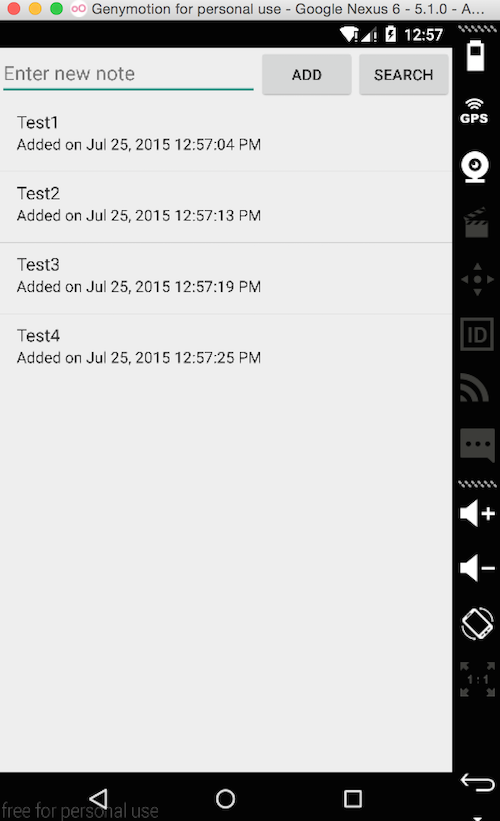
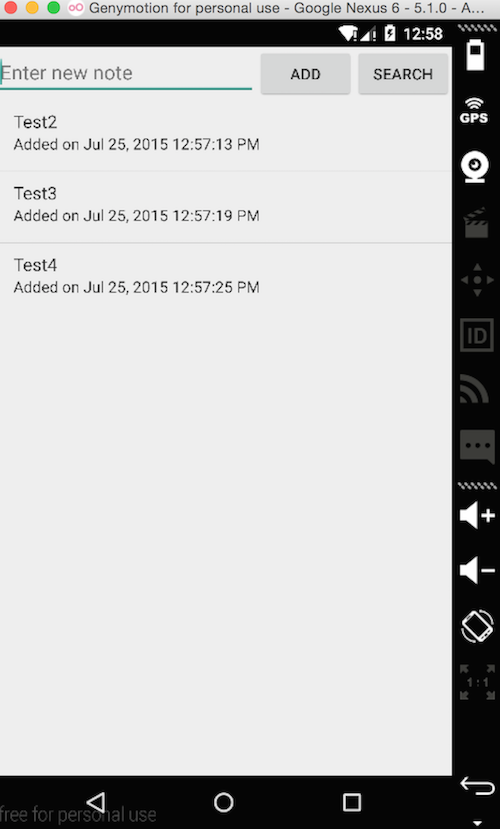

最后
- 本文的 Demo 下载链接:https://github.com/tangqi92/MyGreenDAO
- 本教程旨在介绍 greenDAO 的基本用法与配置,更高级与详细的使用,请参见 官网
- 如本文有任何错误与遗漏,欢迎指正。同时我期待与大家成为朋友,所以欢迎在社交网络上互粉!!!
References & More
http://greendao-orm.com/ https://github.com/greenrobot/greenDAOhttp://stackoverflow.com/questions/tagged/greendaohttps: 原文:http://itangqi.me/android/using-greendao-experience/正文到此结束
热门推荐
相关文章
Loading...











![[HBLOG]公众号](https://www.liuhaihua.cn/img/qrcode_gzh.jpg)

